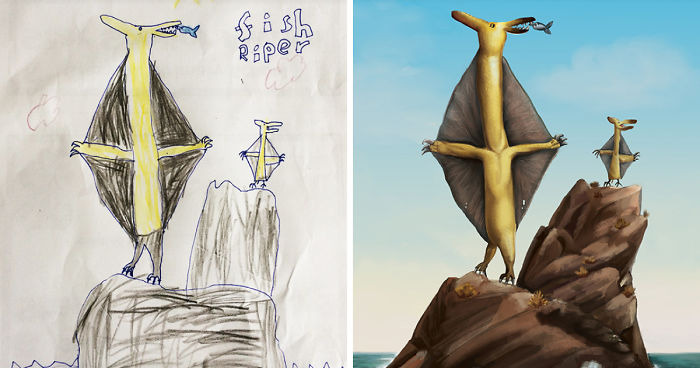
Paleontologist Brings Kids’ Dinosaur Drawings To Life And Decides If They Could Have Existed In Prehistoric Times
We asked a paleontologist, Dougal Dixon, to comment on five kids drawings which were brought to life through digital illustration. The kids then came up with their dinosaur facts, and the paleontologist decided if they would have been able to exist millions of years ago. It’s a battle between imagination and science! For the full piece on these prehistoric dinosaurs see the more info site below.
More info: greatbeanbags.com
The Flynnosaurus
“My drawing ideas was to make it look as unusual as possible but still a real dinosaur. I worked hard. I gave him big teeth to fight with, but I still wanted him to look quite friendly. I have lots of dinosaur things, so when I found the stickers, I thought that would look very unusual.”
by Flynn, aged 5.
VS
“The Flynnasaurus builds its own armor. It is a slow-moving plant-eater, related to the ankylosaurs – the armored dinosaurs. However, unlike its heavy relatives, it never developed the armored plates. The soft skin of its back is attractive to parasites – especially the tiny moth-like pterosaurs and little theropod-like lizards. These are in turn preyed upon by large beetles.”
by Dougal, paleontologist.
The Comotriceratops
“I chose the cosmic blue for my colorful drawing of the Comotriceratops as it reminds me of my school computer screen when it switches on. I made her spotty because it reminds me of a turtle’s shell. She’s a friendly, helpful herbivore that loves to help other species to get food, so they don’t starve. She’s light-footed and graceful and always looks her best.”
by Molly, aged 8.
VS
“Comoticeratops is a ceratopsian one of the horned dinosaurs. A resident of arid uplands, its blue coloration helps it to blend in with the mountain mists. It is a large animal, bigger than the mountain trees on which it feeds. However, it is very exposed and vulnerable to vulture-like pterosaurs of the high crags. It builds up extra armor by rolling in the loose stones of mountainside screes. The stones become embedded in the mucus of its skin, and the skin grows around these and holds them tightly to the body – like the larval cases of caddis-flies”
by Dougal, paleontologist.
The Fish Ripper
“Once in dinosaur times, the fish ripper ruled the sea. It ripped big and little fish out of the sea. It lived around Jurassic times and ate a lot of fish every day. It has rough scales and teaches the younger ones to fly and catch their fish. This was the coolest dinosaur I could do.”
by Oliver, aged 7.
VS
“Fish ripper is a pterosaur, but one that has lost its powers of flight. We have that nowadays – there are plenty of birds that have lost their flying abilities and are perfectly well adapted to life on the ground, or in the water. The penguin is a good example here. In the Fish ripper, the wing membranes are much reduced and form a flat fin-like structure along the neck and the body. It hunts on the bottom of the shallow seas, using its layers as a kind of a camouflage net, blending in with the sandy bottom, as skates and rays do. When a fish comes too close, the elongated body loops up to catch it, like a snake striking, and the Fish ripper makes its way to the surface to eat it.”
by Dougal, paleontologist.
The Polysurrus
“The dinosaur is called Polyosurussunyus Bananashaurus. She is a bit sad because she likes snow, but it’s summer now. She has got a giraffe’s neck because I like giraffes. She is decorated with hearts and glittery shapes because she likes going to parties and likes decorations. She has so many legs because she likes to dance, dance, dance like me! The weather on this day is sunny, but big storm clouds are coming. There is a big puddle in the corner where the dinosaur likes to drink and get clean.”
by Poppy, aged 7.
VS
“It looks as though the Polyosurussunyus Bananashaurus is more of a crab/giraffe instead of a dinosaur! It lives on land and is disguised as a dinosaur to keep predators away. A long spine on one side of the shell looks like a head and neck, and along spine on the other looks like a tail. It has many eyes, allowing it to see all around and watch out for danger.”
by Dougal, paleontologist.
The Two-O-Saurus
“Two-O-Saurus eats other little dinosaurs and is bad. He has fought with other big dinosaurs to guard his home; that’s why he has big claws and teeth. He has a very loud roar to scare off dinosaurs, and his curly tail can hit them and scratch them.”
by Riley, aged 7.
VS
“Two-o-Saurus has two heads! This has actually happened, not really on a dinosaur but on Hyphalosaurus – a water reptile that lived in China in early Cretaceous times, alongside the dinosaurs. We have one fossil of this. It did not live long, as the fossil is of a baby.”
by Dougal, paleontologist.
776views
Share on FacebookIf The Fish Ripper can no longer fly...... How did it end up on a rock in the middle of the sea????? You telling me it swam??? It has claws and no web feet so not sure I believe that.
If The Fish Ripper can no longer fly...... How did it end up on a rock in the middle of the sea????? You telling me it swam??? It has claws and no web feet so not sure I believe that.
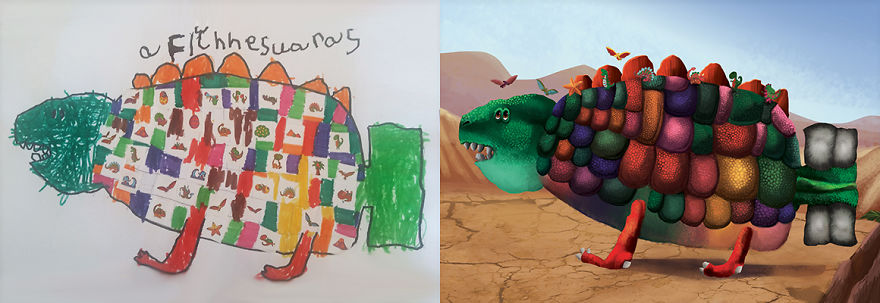
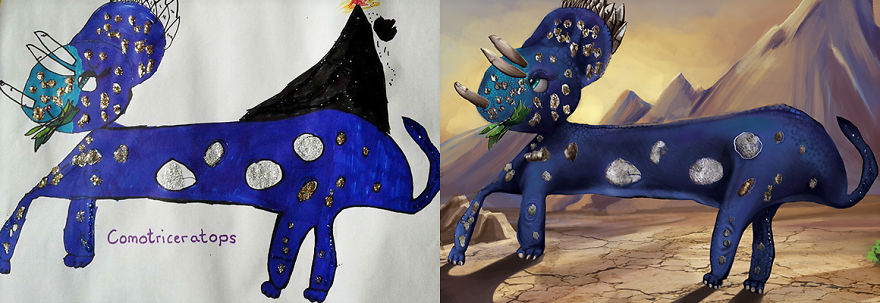
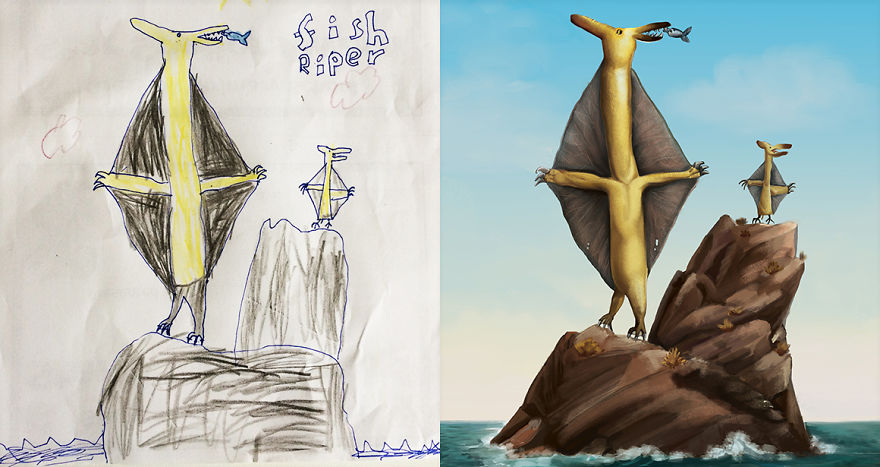
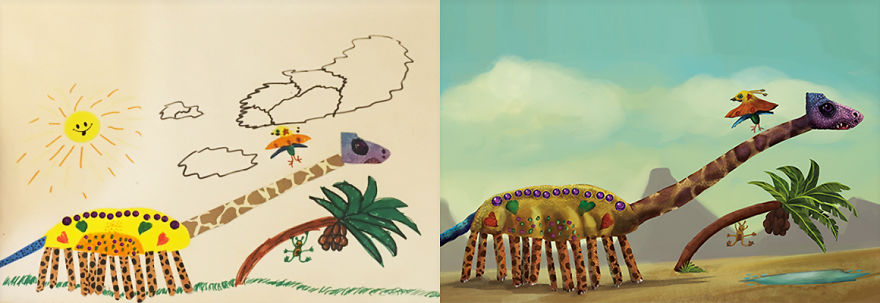
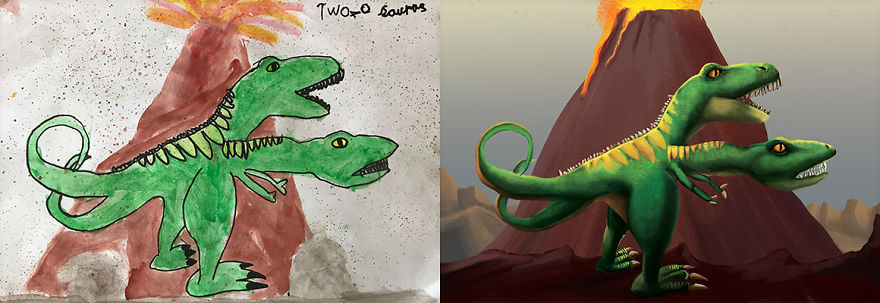



37
2